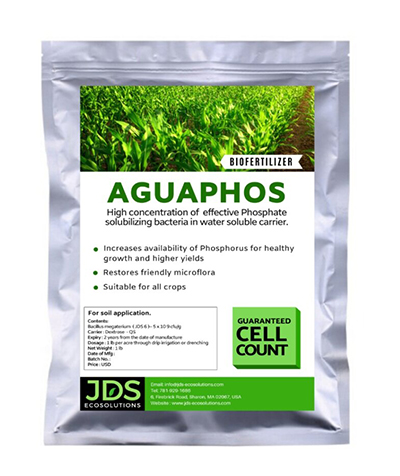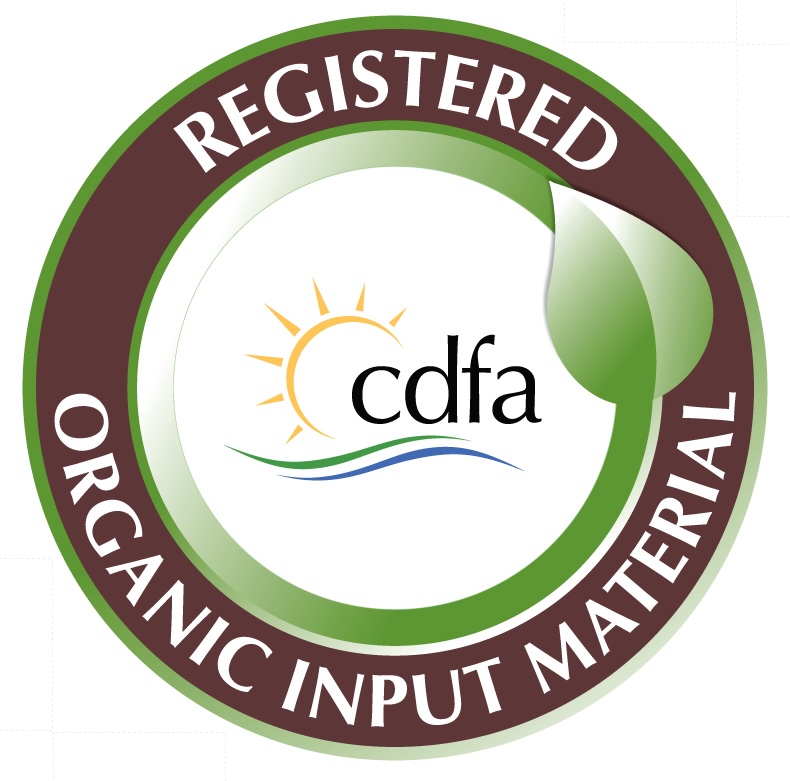Products
Aguaphos®



AguaPhos is a microbial inoculant made up of a high efficacy strain (JDS6) Bacillus Megaterium, with a concentrated dose of 5×10 9 cfu/g.
Benefits:
- Enhanced nutrient availability: AguaPhos can be used to promote plant growth and nutrient uptake., AguaPhos can help solubilize soil nutrients, such as phosphorus, and make them more available to plants. AguaPhos can also produce plant growth – promoting hormones and enzymes that can stimulate root growth and improve nutrient uptake. Additionally, AguaPhos can produce plant growth promoting substances, such as auxins, gibberellins, and cytokinins, that can stimulate plant growth and development. This can help increase crop yields and improve the overall health and quality of the plants.
- Increased disease resistance: AguaPhos has also been found to improve the resistance of plants to diseases. This bacterium can stimulate the plant’s natural defense mechanisms, reducing the incidence of diseases and resulting in healthier plants. This improved disease resistance can lead to reduced use of pesticides and other chemicals, making AguaPhos a valuable tool for organic and sustainable agriculture. By using AguaPhos, farmers and growers can improve the sustainability of their agricultural practices and reduce their reliance on chemical fertilizers and pesticides.
- Stress tolerance: Aguaphos has the ability to tolerate unfavorable environmental conditions and stimulates flower blooms, seed development, and earlier crop maturity. AguaPhos has also been found to increase the stress tolerance of plants, helping them to withstand environmental stressors, such as drought, high temperatures, and soil salinity. This increased stress tolerance can result in higher crop yields and improved plant survival, making AguaPhos a valuable tool for sustainable agriculture.
- Stimulated plant growth and yield: Aguaphos can help in increased nutrient uptake, improved plant growth and enhanced root development. As a result, plants tend to exhibit accelerated growth, increased biomass, and higher yield potential.
- Environmental sustainability: By improving nutrient availability and reducing the reliance on synthetic fertilizers, Aguaphos can contribute to sustainable agriculture practices. These beneficial microorganisms enhance nutrient uptake and minimize nutrient runoff, thereby reducing environmental pollution and preserving ecosystem health.
- Improved soil fertility and structure: The beneficial bacteria in Aguaphos can contribute to the improvement of soil fertility and structure. The bacteria aid in the decomposition of organic matter and the release of nutrients. The combination of both promotes the development of a healthy soil ecosystem, leading to improved soil fertility, water retention, and overall soil structure.
MycoMor Ultra®


About:
MycoMor ULTRA combines a blend of robust strains of endo- and ectomycorrhizae with beneficial rhizobacteria to provide significant benefits for plant growth, disease resistance and soil health. Its active organisms include the following:
- Endo-mycorrhizae (120 propagules/g): Glomus Intradices, Glomus Mossae, Glomus Etunicatum, Glomus Deserticola
- Ecto-mycorrhizae (300,000 propagules/g): Pisolithus Tinctorius, Scleroderma Citrinum, Rhizopogon Luteolus
- Rhizobacteria (56,000,000 cfu/g): Bacillus Subtilus, B. Amyloliquefaciens, B. Licheniformis,
B. Megaterium, B. Pumillus
Benefits:
There are some significant benefits of using MycoMor ULTRA. Its mycorrhizal blend is specifically designed to allow for a broader range of nutrient uptake and a wider range of protection against various soil borne diseases. The blend also allows for broad application on plants, turf, and trees. Its rhizobacteria blend is also optimized to promote plant growth, enhance nutrient availability, suppress diseases, increase stress tolerance, aid in soil remediation, and contribute to environmental sustainability. The blend provides a comprehensive approach to improving plant health and productivity, while reducing the need for synthetic fertilizers and pesticides. By utilizing MycoMor ULTRA, farmers and gardeners can promote sustainable practices and achieve healthier, more resilient plants. Here are more details on the benefits:
- Enhanced nutrient availability: Mycorrhizal fungi improve nutrient uptake by extending their hyphae into the soil, while rhizobacteria enhance nutrient availability by solubilizing and mobilizing essential nutrients. When used together, the blend of mycorrhizae and rhizobacteria work synergistically to increase nutrient availability in the soil, leading to improved plant nutrition and growth. The combination of endo- and ecto mycorrhizae allows for an even broader range of nutrient uptake.
- Increased disease resistance: The rhizobacteria mix in MycoMor has the ability to produce antimicrobial compounds and stimulate plant defense mechanisms, which can help protect plants against diseases. Mycorrhizae also form a physical barrier around the roots, preventing harmful organisms from entering, and also produce secondary metabolites that inhibit the growth of pathogenic fungi. By combining endo- and ectomycorrhizae, the plant gains a wider range of protection against various soil-borne diseases.
- Improved soil fertility and structure: Both mycorrhizal fungi and rhizobacteria contribute to the improvement of soil fertility and structure. Mycorrhizae enhance nutrient cycling and soil aggregation, while rhizobacteria aid in the decomposition of organic matter and the release of nutrients. The combination of both promotes the development of a healthy soil ecosystem, leading to improved soil fertility, water retention, and overall soil structure.
- Stimulated plant growth and yield: The symbiotic relationships established by
mycorrhizal fungi and rhizobacteria result in increased nutrient uptake, improved plant
hormone balance, and enhanced root development. As a result, plants tend to exhibit
accelerated growth, increased biomass, and higher yield potential when benefiting from
the synergistic effects of mycorrhizae and rhizobacteria. - Environmental sustainability: By improving nutrient availability and reducing the reliance on synthetic fertilizers, the combination of mycorrhizae and rhizobacteria can
contribute to sustainable agriculture practices. These beneficial microorganisms enhance nutrient use efficiency and minimize nutrient runoff, thereby reducing environmental
pollution and preserving ecosystem health. - Stress tolerance: Both mycorrhizae and rhizobacteria can enhance plant tolerance to various stresses, including drought, salinity, and heavy metal toxicity. The combination of these microorganisms can provide a more comprehensive stress management system, allowing plants to better withstand challenging environmental conditions.
It’s important to note that the effectiveness of the blend of endo- and ectomycorrhizae with
rhizobacteria may depend on factors such as the specific plant species, soil conditions, and the
compatibility between the microorganisms used. Site-specific evaluations and considering the
specific needs of the target plants are crucial when utilizing this combination to maximize its
benefits.
Dosage:
- Lawn/Turf: Use 1-lb per 5000 sq. ft. Mix with appropriate amount of water and apply as soil drench. It is recommended to apply during initial phase as well as twice a year after that. Apply when soil temperatures are suitable for microbial activity and root growth which is typical in Spring and Fall. Avoid using excessive pesticicides and fungicides that may harm beneficial fungi
- New Plantings: Use 1-lb per cu yard of soil used to fill growing trays for seedlings and transplants. This ensures early colonization and establishment of the mycorrhizal association.
- Established plants and trees: Mix about 1-tsp per 10 gallons, and water normally about
twice a year to maintain and reinforce the mycorrhizal association. - Potting soil: Use 1-lb per cu. yard
- Compost: Use ½-lb per cu. yard
